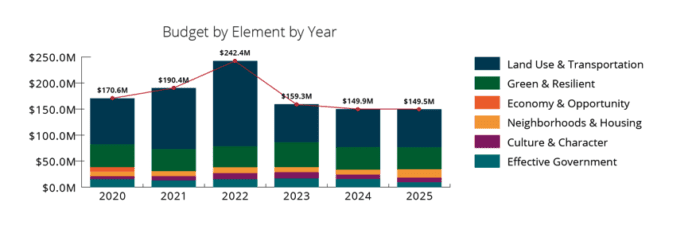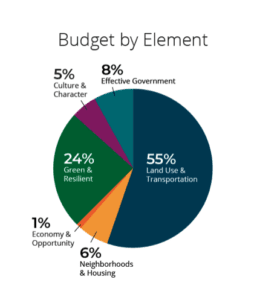Ok, so, here’s where the campaign promises get kept or broken . . . do you see what I see? (A picture says 1,000 words) Majority of the photos below taken from the “Project Map” on the city’s budget page.
Here’s the short video if you want to watch.
Or, if you don’t want to watch, here’s the re-cap.
Mayor thanks people for coming. She says they are here to release her first capital budget. She says that every budget is a statement of our values and her capital budget is rooted in her vision of how Madison can be a great city, where everyone has the opportunity to thrive. That vision is not yet fully realized. Housing has become much less affordable for many in our city, traffic congestion is increasing and families lack affordable transportation options. The impacts of climate change are causing real problems in our neighborhoods and we still have deep racial disparities in opportunity and outcomes in our community. We must and we will overcome these challenges in way that are innovative and inclusive. Her priorities for our great city are clear: Affordable Housing for all residents and the expansion of our transit system to ensure fast reliable and accessible service. She is committed to doing this work through the dual lenses of equity and sustainability. And she is committed to doing it in a fiscally responsible way. For the first time this year all 192 capital items that were proposed by agencies were required to be connected to an element of our comprehensive plan, Imagine Madison. Each proposed capital item was analyzed through a set of criteria to determine those projects that were the highest priority, demonstrated the highest level of readiness and also connected to our values around equity and sustainability. She used the feedback from that process to develop her 1.1 billion plan for capital investments over the next 6 years. We know the capital needs in our growing city are great and exceed the financial capacity of what some of our residents can afford. Her first capital budget lowers our general obligation debt from what was requested by departments by $116M. You can see that in the graph.
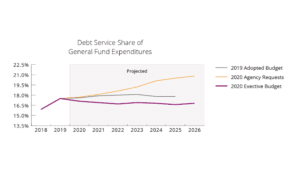
LAND USE AND TRANSPORTATION
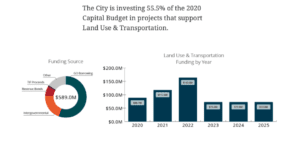
In crafting the capital budget they focused on the topics laid out in the comprehensive plan and her priorities. In the area of land use and transportation they focused on the fact that Madison is a growing city. Over the past 20 years almost 50,000 people have moved into the city and in the next 30 our region is expected to add another 100,000. We can’t turn the Isthmus into a super highway so we need transportation options that don’t rely on the automobile, so we need to build on our success as a transit city and grow a more modern transit system that is regional, fast and reliable.
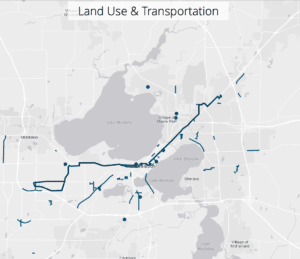
Toward this end her budget includes funding for:
– The implementation of the first phase of bus rapid transit by 2024. Bus rapid transit will use dedicated lanes, modern stations, larger buses and other enhancements to expand service and reduce transit times for Metro uses by up to 25%.
– We are also modernizing the metro headquarter facilities and our really ancient bus barn to meet the demand for new buses and prepare for more electric vehicles while we ensure the health and safety needs of our metro employees. We are investing in our metro bus facility to increase our capacity to store buses and to prepare for the expanded service with a goal of seeing our annual ridership reach 18,000,000.
– We are enhancing the city’s pedestrian and bike path infrastructure and expanding our overall path network in the city and
– Continuing to make priority investments in our street network.
NEIGHBORHOODS AND HOUSING
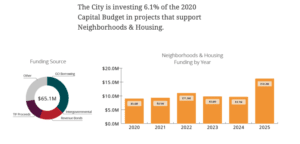
As Madison grows, the landscape of our housing market and neighborhoods has also changed. From 2007 – 2015 9 out of 10 new Madisonians were renters. 9 out of 10. Our new development has been primarily in multi-family units. Despite that, we have seen the vacancy rate fall from 5.6% to 2.8% which is contributing to the lack of affordability that we see. We need that vacancy rate to get back closer to 5%. Part of the way that we do that, to ensure that everyone in Madison has access to affordable housing in complete neighborhoods is by investing in affordable housing. In this budget they are:
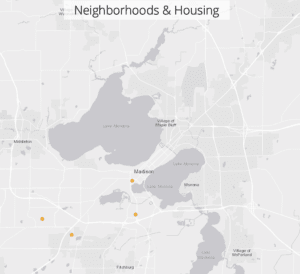
– Creating a new land banking fund that makes $1M available annually to acquire parcels of land that can be used for affordable housing and other neighborhood supporting developments.
– We are increasing funding for the affordable housing program and
– We are continuing to support families who are purchasing a new home or staying in their homes through existing programs.
CLIMATE ISSUES
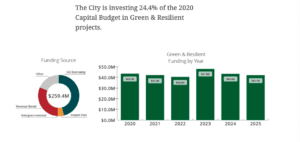
We know that our climate is rapidly changing and as weather patterns continue to be increasingly unpredictable, we need to both decrease our climate changing emissions as a city while we prepare for the impacts of climate disruption. This budget does that by continued investment in our sustainability program.
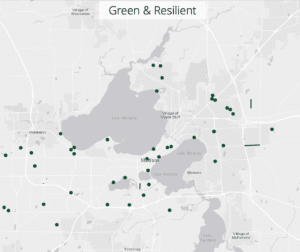
In the next year we will be funding:
– Our Green Power Training Program
– Solar installations on city buildings and purchasing renewable energy credits. It is our goal to increase the city’s energy generated from renewable sources by 33% in 2020.
– We are also increasing investments in flood mitigation projects with an emphasis on using green infrastructure in new ways so we can dramatically decrease the number of buildings and roadways that flood during extreme rain events.
– We are making a continued investment in electric vehicles for the city’s fleet, which will both reduce our emission and save significantly on maintenance costs.
– And, including funding to study ways to keep PFAS and chloride contamination that results from winter salt use out of our wells and our drinking water
ECONOMY AND OPPORTUNITY
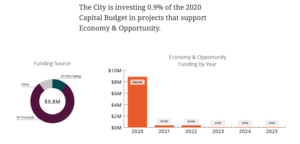
Turning to the economy, we know that a strong and diversified economy that works for everyone is critical. And its a critical element to ensuring that Madison continues to grow and thrive. Although we see strength in these areas, there are very real disparities in household income and educational attainment, between communities of color and white families.
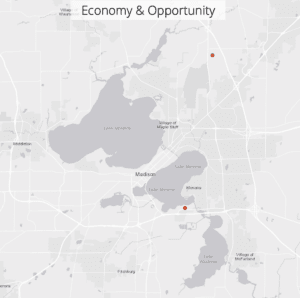
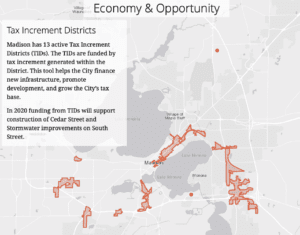
In addition to the investments we are making in affordable housing, transit, local food access, parks and libraries, the 2020 capital improvement plan seeks to reverse some of these trends by:
– Continuing funding for our cooperative business development program. This program provides grants and training to cooperatives that are focused on job creation and in 2020 we will seek to support up to 6 newly incorporated business cooperatives.
– We are also planning an equity business initiative providing support for entrepreneurship and business development in communities of color and communities that historically face barriers in entering the market. This program was started under the previous administration, but we haven’t yet had the conversations with business owners and entrepreneurs of color that we need to have to adequately plan it, so that planning will be happening in the next year.
She says she wants to mention, just briefly, the public market. The public market is a project that has been debated in the community for a number of years. She recognizes the public market’s ability to support businesses and cultivate entrepreneurship, particularly in food related businesses. So her budget anticipates construction of the public market will continue as planned but it transfers the city’s capital funding share, which is $7.5M to revenue from the Tax Increment District that runs along the East Washington Ave. corridor and it also calls for the Madison Public Market Foundation to raise an additional half million to complete the project. She feels like this a more appropriate source of funding for the market because it is related directly to economic development and it is only fair as we are tightening our belts and sharpening our pencils to ask our partners to share some of that as well.
EFFECTIVE GOVERNMENT
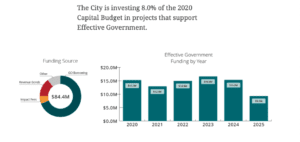
Finally she wants to address effective government. It is our goal to continue to push to an efficient and high performing government.
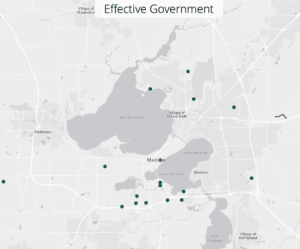
The 2020 budget advances these priorities in part by investing in:
– New IT systems, particularly around property assessment and tax systems. These systems will help us ensure that commercial properties pay their fair share of taxes.
– And they are improving access to city services and increasing employee efficiency and moral by remodeling city office space, most notably the clerk’s office which is in “not great shape” and we need to make sure as we move into some big elections in the next that the clerk is prepared to do that.
– – –
CULTURE AND CHARACTER
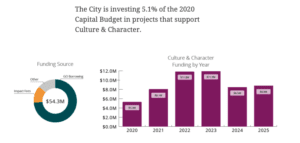
She didn’t address this in her comments.
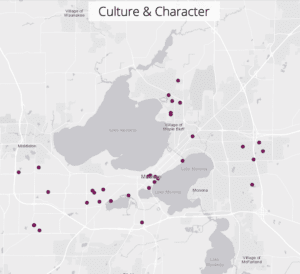
– – –
Together, we will continue to meet our challenges as a city, and achieve our priorities. Our vision, my vision is a Madison that is innovative, inclusive and thriving. I want that vision to be realized for all of our residents and my 2020 capital budget sets a path towards that goal. Thank you all for being here and I’m happy to take a few questions.
QUESTIONS
Q: What was the driving force behind the Horizons list and how did that idea come about?
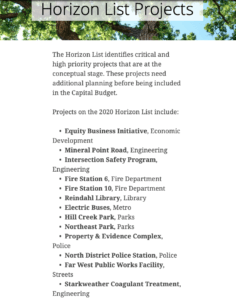
A: That idea originated in the finance department but she thinks its a brilliant solution to a problem that the capital budget has long had. So, often in the past we would see projects placed into the Capital Improvement Plan (CIP, pronounced sip) as a placeholder. Someone was saying I really hope this happens. The horizon list is a place where projects we are interested in or even committed to can sit until they are fully planned and until we know what their scope is, what their price tag is. From the horizon list a project could come into the 2021 capital budget directly or it could come into the capital improvement plan at any point. Think of it as truth in budgeting.
Q: You mentioned the Equity Business Initiative, is this the same or are there changes from what Mayor Soglin proposed the week before the election.
A: She anticipates there will be changes, again, the major focus is to speak with entrepreneurs and business owners of color to make sure that we understand the barriers as they perceive them and that we are actually working on things that will help businesses owned by folks of color and some of our disadvantaged neighborhoods.
Q: How do you think building the budget around those elements in the Imagine Madison Plan sort of changed the budgeting process or helped make more clear the city’s priorities
A: It was really important to her that we . . . you know, the city did a tremendous amount of work on Imagine Madison, we did a lot of internal work, but also a lot of external work reaching out to the community in new ways and she thinks more effective ways. And that allowed us to really understand the priorities of the folks that were engaged in the Imagine Madison process and for a comprehensive plan to be really, truly effective, it can’t then just go and sit on a shelf somewhere. So she thinks that the more things that we can do to connect our work back to Imagine Madison the better. And the more that we can have some accountability around “we heard this” in the Imagine Madison process and now “we are doing this” as a result, the better. It certainly helped her focus on where projects fit together and how they met the priorities that were identified in the plan and she thinks they will continue to do more of that over time. She hopes that it also has helped the departments and division focus on their portions of the comprehensive plan and how they fit into that greater work.
Q: On page 8, Fire Station 10 and North District are listed as separate things. Does that mean that the project proposed about a year ago about combining a police and fire station is not being considered any more over by Warner Park?
A: That’s correct, we will move forward separately with a fire station, probably in the site that it is in, but it will need some renovations and we will be likely looking for another spot for a police district on the North Side.
Q: Any idea what the thinking was around not combining the two as opposed to the proposal last year which was a larger facility to house both agencies.
A: That was my decision based on feedback that she received from the agencies and what we think will be most effective in service delivery.
Q: How critical is it that the city work on it’s debt, obviously we saw in the reports that if all requests were funded the share of the debt would have been a 21%, there are obviously a lot of major projects going on. In your own words, how important is it that the city hold the line with its debt share.
A: I think its really important and as you can see this was a focus of the capital budget this year to constrain our debt service in future operating budgets. It’s not easy, there are a lot of capital needs, obviously, but we need to pay attention to the impact on the operating budget and so we actually spent a fair amount of time looking at how to balance the debt load over the entire 6 year program and to really think about the impacts on the operating budget.
Q: Does law enforcement come in a separate budget or is it just not highlighted in the pages we have here.
A: It’s just not highlighted, its part of the effective government section. Both police and fire have a section in the capital budget.
Q: Any changes this year as far as expanding either department or reducing or anything of that nature?
A: There is nothing significant changing. We didn’t give anyone everything they requested in any department, but there is not significant changes.

